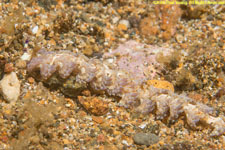
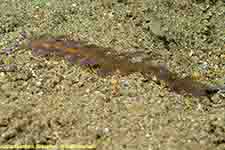
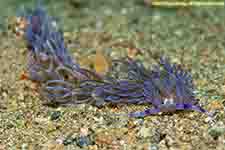
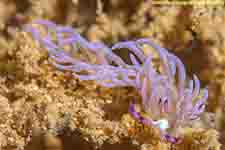 Blue dragon, Pteroeolidia semperi (P. ianthina is a temperate Australian species)
Blue dragon, Pteroeolidia semperi (P. ianthina is a temperate Australian species)We took an underwater photography trip to the Philippines in December 2016. We returned in November 2024.
NOTE: We love nudibranchs, but we are not experts on these animals. If you find something we have misidentified or can identify something we couldn't, email us and we will correct it.
Nudibranchs are soft-bodied marine gastropod molluscs that shed their shells after their larval stage. "Nudibranch" means "naked gills". There are two main kinds of nudibranchs, aeolid nudibranchs and dorid nudibranchs, and two less-common kinds, dendronotids and arminids.
Aeolids have cerata, no bronchial plume, no mantle, and may have zooxanthellae. Lacking separate gills, respiration takes place thorough their cerata, which contain branches of the digestive tractwhich transport nematocysts acquired from coelenterate prety to the ceratal tips, where they are stored and used for the nudibranch's own defense.



 Blue dragon, Pteroeolidia semperi (P. ianthina is a temperate Australian species)
Blue dragon, Pteroeolidia semperi (P. ianthina is a temperate Australian species)
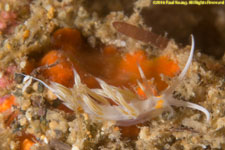 Striated cratena, Cratena cf lineata
Striated cratena, Cratena cf lineata
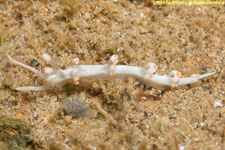
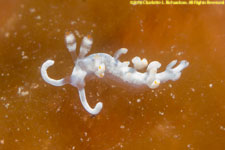 Bicolor flabellina, Flabellina bicolor
Bicolor flabellina, Flabellina bicolor
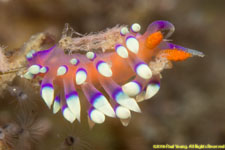 Desirable flabellina coryphellina), Flabellina (Coryphellina) exoptata
Desirable flabellina coryphellina), Flabellina (Coryphellina) exoptata
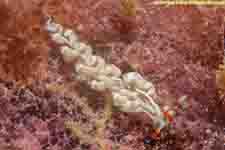
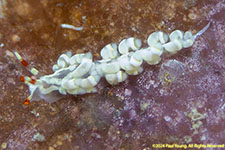 Yellow-ring (Yellow-masked) trichesia, Trichesia sp.
Yellow-ring (Yellow-masked) trichesia, Trichesia sp.
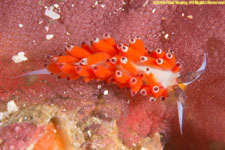
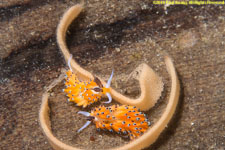
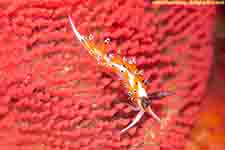 Ringed favorinus, Favorinis tsuruganus
Ringed favorinus, Favorinis tsuruganus
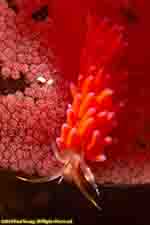 Wonderful (Red) favorinus, Favorinus mirabilis
Wonderful (Red) favorinus, Favorinus mirabilis
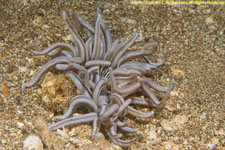
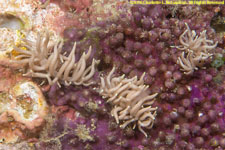
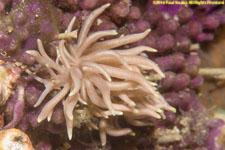 Yellow-tipped phyllodesmium, Phyllodesmium briareum
Yellow-tipped phyllodesmium, Phyllodesmium briareum
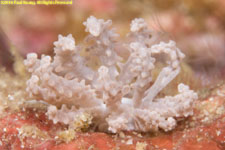 Cryptic phyllodesmium, Phyllodesmium crypticum
Cryptic phyllodesmium, Phyllodesmium crypticum
Dorids, the most common variety of nudibranchs, have a bronchial plume (gills) and mantle. They eat sponges, tunicates, bryozoans, or other opisthobranchs.
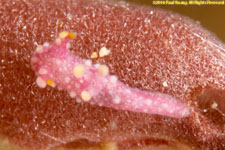 Shaggy (Pink) Aegires, Aegires sp.
Shaggy (Pink) Aegires, Aegires sp.
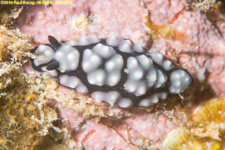
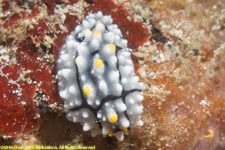
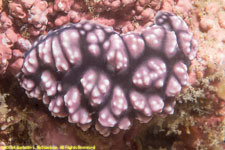
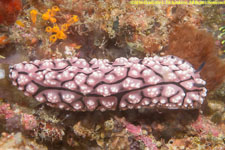
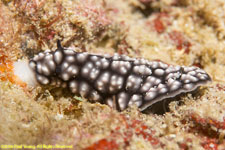
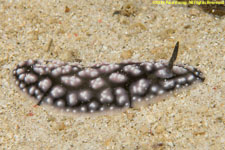
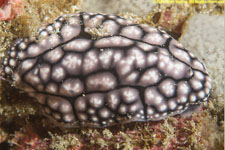 Pimpled phyllidiella, Phyllidiella pustulosa
Pimpled phyllidiella, Phyllidiella pustulosa
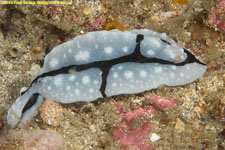 Shireen's phyllidiopsis, Phyllidiopsis shireenae
Shireen's phyllidiopsis, Phyllidiopsis shireenae
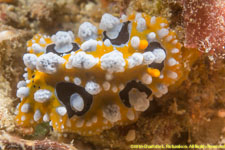 Ocellated phyllidia, Phyllidia ocellata
Ocellated phyllidia, Phyllidia ocellata
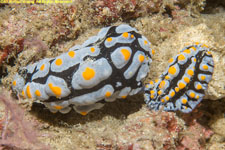
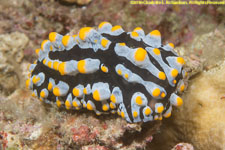 Swollen phyllidia, Phyllidia varicosa
Swollen phyllidia, Phyllidia varicosa
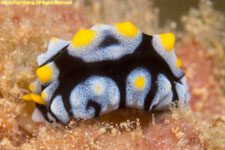 Painted phyllidia, Phyllidia picta
Painted phyllidia, Phyllidia picta
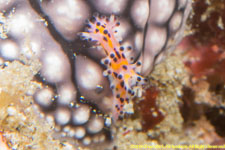 Hairy Norse god, Aegires villosus
Hairy Norse god, Aegires villosus
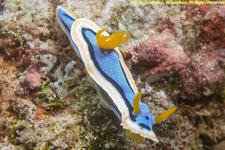
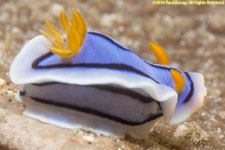 Anna's chromodoris, Chromodoris annae
Anna's chromodoris, Chromodoris annae
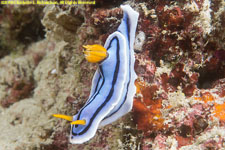 Elisabeth's chromodoris, Chromodoris elizabethina
Elisabeth's chromodoris, Chromodoris elizabethina
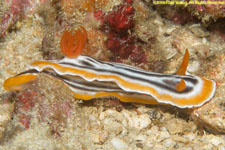
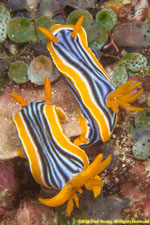 Magnificent chromodoris, Chromodoris magnificata
Magnificent chromodoris, Chromodoris magnificata
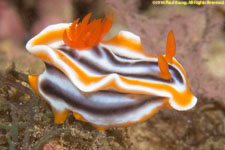
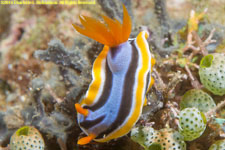
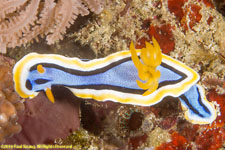
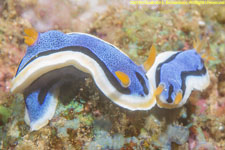
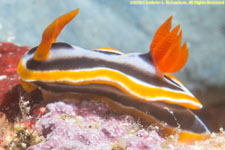
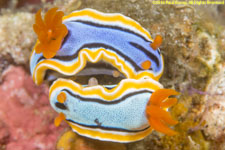 Striated chromodoris, Chromodoris strigata
Striated chromodoris, Chromodoris strigata
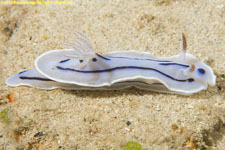
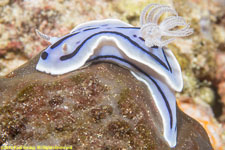
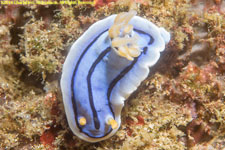
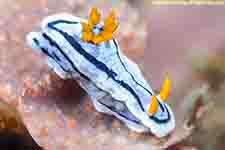 Loch's chromodoris, Chromodoris lochi
Loch's chromodoris, Chromodoris lochi
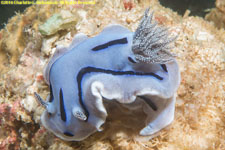
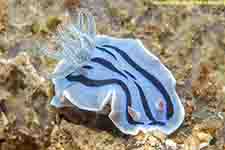
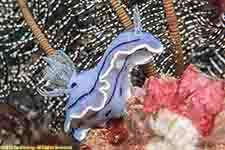 Willan's chromodoris, Chromodoris willani
Willan's chromodoris, Chromodoris willani
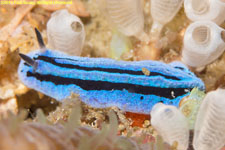 Anne's phyllidiopsis, Phyllidiopsis annae
Anne's phyllidiopsis, Phyllidiopsis annae
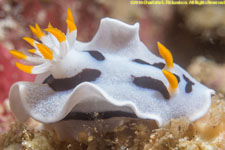
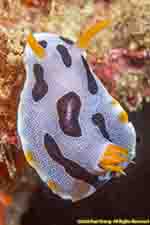 Diana's chromodoris, Chromodoris dianae
Diana's chromodoris, Chromodoris dianae
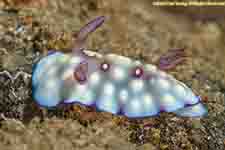 Bus-stop chromodoris, Chromodoris hintuanensis
Bus-stop chromodoris, Chromodoris hintuanensis
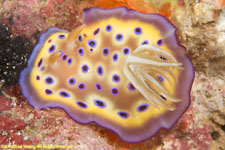 Kunie's chromodoris (goniobranchus), Chromodoris (Goniobranchus) kuniei
Kunie's chromodoris (goniobranchus), Chromodoris (Goniobranchus) kuniei
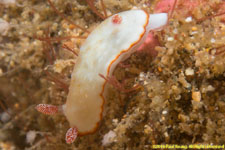 Two-band goniobranchus (chromodoris), Goniobranchus (Chromodoris) verrieri
Two-band goniobranchus (chromodoris), Goniobranchus (Chromodoris) verrieri
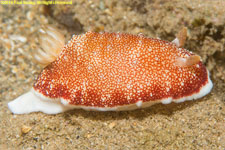 Reticukated (Spotted) goniobranchus (chromodoris), Goniobranchus (Chromodoris) reticulata
Reticukated (Spotted) goniobranchus (chromodoris), Goniobranchus (Chromodoris) reticulata
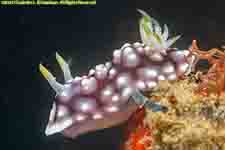 Geometric nudibranch (chromodoris, goniobranchus), Goniobranchus (Chromodoris) geometricus
Geometric nudibranch (chromodoris, goniobranchus), Goniobranchus (Chromodoris) geometricus
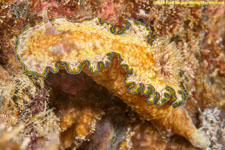 Girdled glossodoris, Glossodoris cincta
Girdled glossodoris, Glossodoris cincta
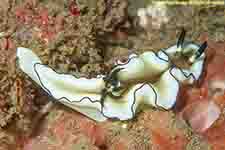 Dark margin glossodoris, Glossodoris atromarginata
Dark margin glossodoris, Glossodoris atromarginata
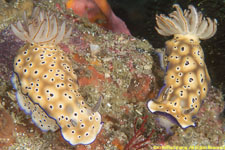
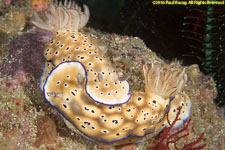
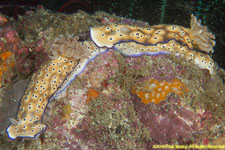 Tryon's risbecia, Risbecia tryoni
Tryon's risbecia, Risbecia tryoni
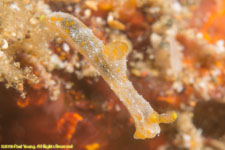
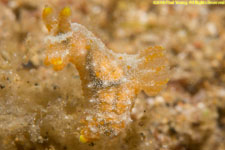
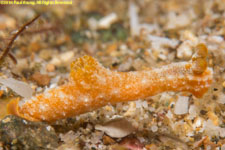 White-dotted polycera, Polycera sp.
White-dotted polycera, Polycera sp.

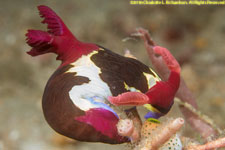
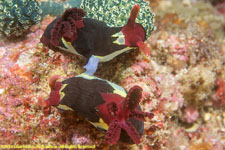
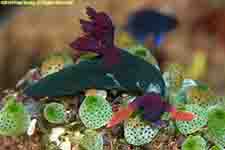 Chamberlain's nembrotha, Nembrotha chamberlaini
Chamberlain's nembrotha, Nembrotha chamberlaini
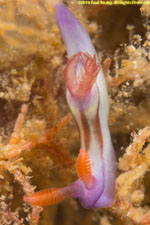 Lined neon slug, Nembrotha lineolata
Lined neon slug, Nembrotha lineolata
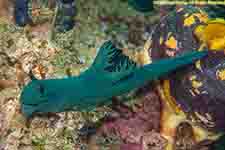
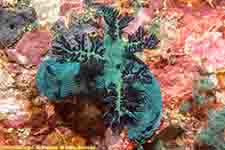 Miller's nembrotha, Nembrotha milleri
Miller's nembrotha, Nembrotha milleri
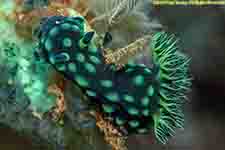 Crested nembrotha, Nembrotha cristata
Crested nembrotha, Nembrotha cristata
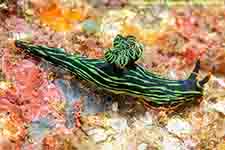 Kubaryana's nembrotha (variable neon slug), Nembrotha kubaryana
Kubaryana's nembrotha (variable neon slug), Nembrotha kubaryana
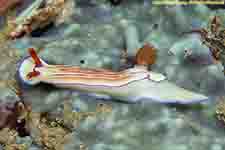 Emma's hypselodoris, Hypselodoris emma
Emma's hypselodoris, Hypselodoris emma
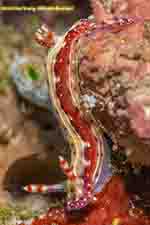 Decorated hypselodoris, Hypselodoris decorata
Decorated hypselodoris, Hypselodoris decorata
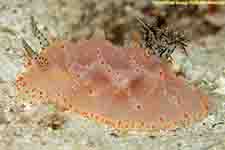
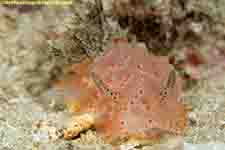 Batangas halgerda, Halgerda batangas
Batangas halgerda, Halgerda batangas
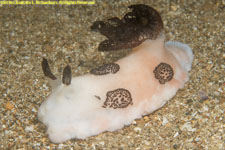 Funeral Jorunna, Jorunna funebris
Funeral Jorunna, Jorunna funebris
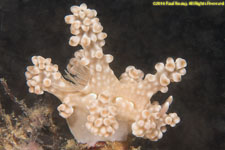
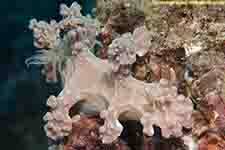
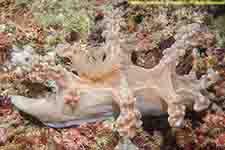 Allen's ceratosoma (miamira), Ceratosoma (Miamira) alleni
Allen's ceratosoma (miamira), Ceratosoma (Miamira) alleni
Dendronotid nudibranchs have branching paired sets of gill structures in rows along both sides of the mantle, and long sheathed rhonophores:
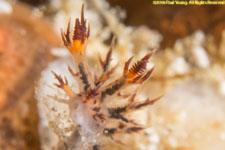 Regal dendronotus, Dendronotus regius
Regal dendronotus, Dendronotus regius
Arminid nudibranchs have bulbous-tipped rhinophores and an oral veil at the front of the head. Most have stripes running the length of the mantle and gills beneath the mantle skirt. We did not photograph any of these here.
Nudibranch eggs:
Related animals:
Pleurobranchs (sidegill slugs) have feather-like gills hidden under the right side of their mantle skirt, and rolled rhinophores:
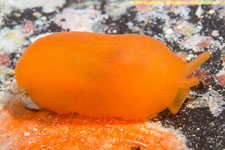
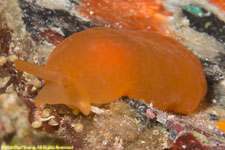 Apricot sidegill slug, Berthellina delicata (citrina)
Apricot sidegill slug, Berthellina delicata (citrina)
Head-shield slugs have a shield-shaped head but lack true rhinophores:
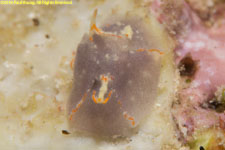
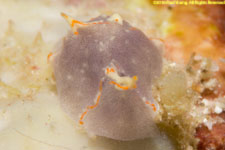
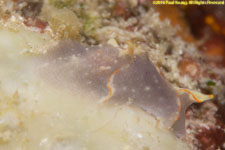
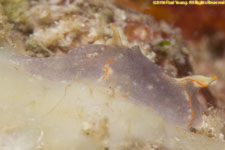 White-margin Sagaminopteron, Sagaminopteron nigropunctatum (ornatum)
White-margin Sagaminopteron, Sagaminopteron nigropunctatum (ornatum)
Sea hares have rolled rhinophores, a pair of oral tentacles, and a pair of large skin flaps on their backs (parapodia). We did not photograph any of these here.
Sapsucking slugs (sacoglossids) have rolled rhinophores and are mostly green:
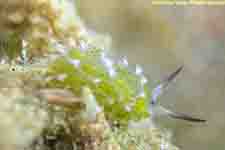 Kuro sapsucking slug, Costaciello kuroshimae
Kuro sapsucking slug, Costaciello kuroshimae
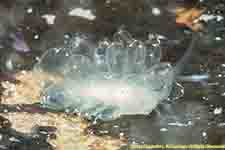
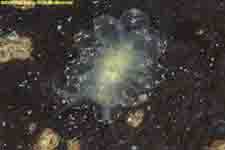 Elegant sapsucking slug (elegant butterfly slug, elegant cyerce), Cyerce elegans
Elegant sapsucking slug (elegant butterfly slug, elegant cyerce), Cyerce elegans
©2016, 2017, 2024, 2025 Mermaid Underwater Photographic. All Rights Reserved.
Contact us at mermaid@underwater.org.
Last modified 10 November 2025